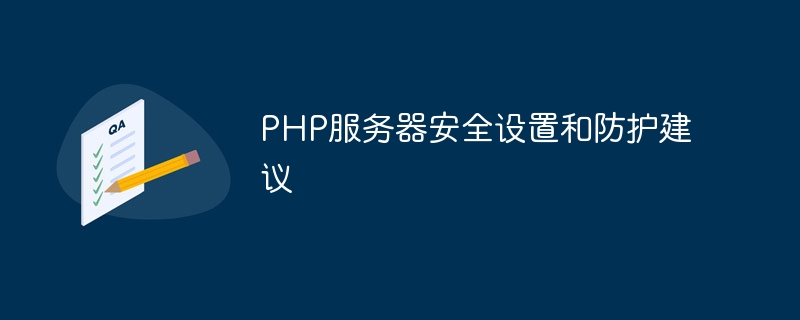

PHP server security settings and protection recommendations
With the development of the Internet, PHP has become a very popular server-side scripting language and is widely used in Web development. However, due to its openness and easy-to-learn characteristics, PHP servers have also become one of the targets of hacker attacks. In order to protect the security of servers and applications, we need to take some security settings and protective measures.
The following will introduce you to some security settings and protection suggestions for PHP servers:
Update PHP version regularly to ensure server security one of the important measures. New versions usually fix security vulnerabilities that existed in older versions. What's more, updated versions also introduce new security features and enhancements. Keep the latest PHP version possible to increase server security.
PHP’s error reporting function can expose sensitive information of the server, providing hackers with the possibility of attack. In a production environment, error reporting should be disabled to avoid leaking sensitive information. In the php.ini file, set error_reporting to 0 to turn off error reporting.
error_reporting(0);
When performing MySQL queries using user-supplied data directly in a PHP application, there is a risk of SQL injection. To prevent SQL injection attacks, prepared statements should be used or user-entered data should be escaped. Here is sample code for querying with PDO prepared statements:
$pdo = new PDO("mysql:host=localhost;dbname=test", $username, $password);
$stmt = $pdo->prepare("SELECT * FROM users WHERE username = :username");
$stmt->bindParam(":username", $_GET['username']);
$stmt->execute();
$result = $stmt->fetch(PDO::FETCH_ASSOC);PHP scripts and related files running on the server should have appropriate File permissions to protect the server from unauthorized access or modification. Generally speaking, the permissions of PHP files should be set to 0644, and the permissions of directories should be set to 0755. The following code can be used to modify file permissions:
chmod("/path/to/file.php", 0644);
chmod("/path/to/directory", 0755);When processing user input, it needs to be strictly filtered and verified to prevent malicious Input and cross-site scripting attacks (XSS). Use PHP's filter function to check user-entered data and filter out potentially malicious code. For example, using the filter_var function you can verify email addresses:
$email = $_POST['email'];
if(filter_var($email, FILTER_VALIDATE_EMAIL)){
// 邮箱地址有效
} else {
// 邮箱地址无效
}The file upload function is a common security vulnerability that allows hackers to upload malicious files to hack into the server. In order to prevent file upload vulnerabilities, it is necessary to limit the type, size and storage path of uploaded files, and to strictly inspect and filter uploaded files. The following is a simple file upload sample code:
$target_dir = "/path/to/uploads/";
$target_file = $target_dir . basename($_FILES["file"]["name"]);
$uploadOk = 1;
$imageFileType = strtolower(pathinfo($target_file,PATHINFO_EXTENSION));
// 检查文件大小
if ($_FILES["file"]["size"] > 500000) {
echo "文件太大。";
$uploadOk = 0;
}
// 检查文件类型
if($imageFileType != "jpg" && $imageFileType != "png" && $imageFileType != "jpeg"
&& $imageFileType != "gif" ) {
echo "只允许上传JPG, JPEG, PNG 或 GIF 文件。";
$uploadOk = 0;
}
if ($uploadOk == 0) {
echo "文件上传失败。";
} else {
if (move_uploaded_file($_FILES["file"]["tmp_name"], $target_file)) {
echo "文件上传成功。";
} else {
echo "文件上传失败。";
}
}In summary, server security settings and protection are important tasks to protect PHP applications. By updating the PHP version, turning off error reporting, using secure MySQL queries, setting appropriate file permissions, filtering user input, and preventing file upload vulnerabilities, you can improve the security of your PHP server and reduce the risk of being attacked by hackers. Everyone must pay attention to security issues when developing PHP applications, and always pay attention to the latest security recommendations and best practices.
The above is the detailed content of PHP server security settings and protection recommendations. For more information, please follow other related articles on the PHP Chinese website!




